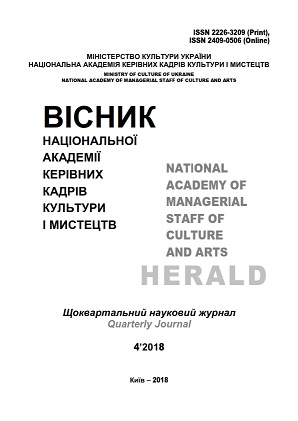Паратекстуальне програмування ансамблевих п'єс українських композиторів: змістовий та мовно-виражальний аспекти синестетичних асоціацій
Paratextual Programming of Ensemble Works by Ukrainian Composers: Semantic and Semiotic Expressive Aspects of Synesthetic Associations
Author(s): Anastasia Igorivna KravchenkoSubject(s): Semiotics / Semiology, Music, Recent History (1900 till today), Semantics, History of Art
Published by: Національна академія керівних кадрів культури і мистецтв
Keywords: chamber ensemble of Ukraine; paratextuality; paratextual programming; ekphrasis; interart synesthesia; semiotic translation;
Summary/Abstract: The purpose of the article is to study the Ukrainian chamber creativity of the late 20th – early 21st centuries from the point of view of analyzing the methods of paratextual programming of ensemble pieces for various types of thematic and meaningful representativeness and related processes of music inheritance of some artistic and expressive functions «transposed» from unrelated arts. Methodology. Used a set of methodological approaches of textological, semantic, synesthetic, cultural analysis. Scientific novelty. The study of paratextual programming of the compositions of the chamber art of Ukraine of the late XX – early XXI centuries allowed, on the one hand, to emphasize thematic areas of representation in music of artistic images (plots, themes, motifs) from works of other arts. On the other hand, it made it possible to detect the presence of interaction between different types of art not only at the semantic but also at the semiotic-expressive levels, which is implemented through the introduction of specific techniques of the semiotic «translation» of semantic and structural «cliches» of rhetorical, graphic, plastic, theatrical expression. Conclusions. Systematization of methods of paratextual programming of chamber art works in Ukraine in the late ХХ and early ХХІ centuries allows us to single out several groups of their thematic representativeness on the principle of interaction in musical-literary, -visual, - theatrical and -movie correlations. The intersemiotic semantic connection of the musical text with its paratextual component (reflected in names, auto-commentaries, remarks, epigraphs, dedications) is often emphasized in a semiotic and expressive manner. The study of this process reveals that at an semiotic level of comparison and identification of stylistic techniques (which initially have a non-musical species origin and a method of artistic and material embodiment) is carried out by means of technical and compositional operation with rich sound-visual resources of music. The potential of their disclosure (using intonation, microtonic, timbre, phonical, textural, polyphonic means, including «voiced silence») is aimed at obtaining a synesthetic perceptual effect that creates the illusion of semiotic conformity and a kind of «transfer» to the audible space of ensemble compositions of extra-musical artistic and expressive techniques and functions.
Journal: Вісник Національної академії керівних кадрів культури і мистецтв
- Issue Year: 2018
- Issue No: 4
- Page Range: 290-295
- Page Count: 6
- Language: Ukrainian

